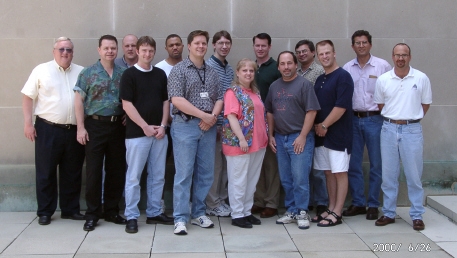

Mission Status Report #36 Star Date: September 18, 2000 Caption: The FUSE Mission Operations Team gathers for an informal portrait outside the Bloomberg Center for Physics and Astronomy at JHU, June 26, 2000. (Photo courtesy of Paul Forness.)
(Click image above to see larger version.)
FUSE is CruisingHello World, Once again it has been much too long since my last report, for which I apologize. (I've been doing that a lot lately!) Things get busy, and Web reports are only one of the things I do; sometimes they have to take the back seat. The FUSE satellite continues to work well and is gathering data of excellent quality in an efficient manner. Averaged over the last two month period, our science efficiency (which measures the amount of time spent exposing on science targets compared with wall clock time) has averaged around 30%. This number does not include calibration observations or time spent on alignment activities or other maintenance activities, and is an excellent number for a low earth orbiting telescope. We are pursuing ways of improving this number even further as we proceed with the mission. We had one significant anomaly since the last report. One of four so-called "reaction wheels" (also called momentum wheels) sensed a problem and shut itself down. Reaction wheels are the devices that a satellite like FUSE uses to change it's pointing direction in space. By changing the rates of spin of these wheels in a controlled manner, torques (forces) are generated that make the telescope move. (Recall FUSE contains no "jets" or fueled rockets, so this is the only way we can point around the sky to different objects.) It turns out that we can operate just fine on three wheels, and we recovered from this problem in only 18 hours. But we do need at least three wheels to operate, so we were without any redundancy for the last 6 weeks. If another wheel had a problem, we would have had to terminate science operations and spend full time trouble shooting. Just last week we were able to bring the errant reaction wheel back on line and are now operating with four good wheels again! Troubleshooting on a non-interference basis, plus work with our commercial and engineering partners, allowed us to assess and correct the situation. Our thanks to all who helped work through this problem and gave us back some important insurance. The picture above features our dedicated Mission Operations Team. These are the folks responsible for communicating with the satellite and analyzing the telemetry regarding health and safety of the satellite. Their work schedules rotate around the clock as needed to cover the periods when we have ground station contacts. We couldn't do it without them! Other good news includes progress toward Cycle 2 of FUSE operations and beyond. We received 134 proposal requests from astronomers all over the world for Cycle 2. These have been carefully reviewed for technical feasibility and the selection process (run by NASA) will occur over the next couple of weeks. In addition, we have heard that the FUSE project was rated highly by NASA's biannual "Senior Review", so that continued operations for Cycles 3, 4, and 5 are "GO", pending continued performance of the satellite. We are pleased indeed that this satellite mission, developed and now operated in the University environment, has received a strong vote of support by NASA and the community. Over the next month, a couple of significant things are planned for FUSE. The first involves our first observation of a moving target. Solar system targets are difficult objects to observe from earth orbit because they move with respect to the background stars. Hence, instead of just locking onto guide stars and holding position, a satellite has to step across the sky to follow the target. Over the last several months, we have performed a number of tests of this capability to verify the ground system and satellite agree on all the details. In the near future, we will try this on an actual moving target. It is our hope to establish moving targets as a standard part of FUSE oeprations in Cycle 2, (although it will never be "routine"). Stay tuned! Another special activity involves a 2.5 week campaign of observations that concentrate on the Magellanic Clouds in the southern sky. These two so-called "Local group" galaxies contain many stars and other objects of interest that can be observed by FUSE and are of great interest to astronomers. Because of thermal concerns in maintaining the alignment of our four telescopes (see Status Report#24), we cannot just point anywhere at any time. We must manage the changes in ways that allow us to keep things aligned. There are several Cycle 1 programs that require "monitoring" of targets in these two galaxies (that is, repeated observations over a number of days) to search for variability in the data from key objects. Hence, we have put months of planning effort into this upcoming observing campaign in order to accommodate these programs. Wish us luck! Reported by: Bill Blair, Chief of Mission Planning
|
